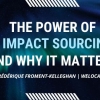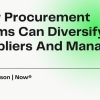In order to improve ESG performance, organizations must be more open about reporting ESG risks, disclose ESG metrics in line with industry peers, find a way to track hard-to-find metrics like supplier diversity, and tap technology to improve ESG governance and risk management says Riskonnect CEO Jim Wetekamp. He shares four ESG supply chain considerations for every risk and sourcing leader who wants to proactively improve ESG performance.
The pressure is on to strengthen environmental, social and governance (ESG) performance. ESG factors influence a multitude of critical decisions – from where people invest to where they work. Indeed, 42% of consumers say they will only buy from brands that align with their values.
Maybe you have taken steps to integrate ESG into operations, but what’s next? Given that two-thirds of the average company’s ESG footprint lies with its suppliers and nearly 90% of greenhouse-gas emissions come from a company’s supply chain, the answer is simple: your third parties. Even small, incremental improvements on environmental and social factors within the supply chain can significantly improve your overall ESG performance.
Here are four ESG supply chain considerations for every risk and sourcing leader who wants to proactively improve ESG performance.
1. Be More Open About Reporting ESG Risks
Everyone is leery of “greenwashing.” Customers and stakeholders want to know that the companies they work for and do business with are being authentic in their commitments – and transparency is critical to delivering on expectations.
While most ESG reporting today is voluntary, regulations are imminent. But don’t wait for specific requirements to shake out. Be proactive and start reporting on the ESG metrics most important to your organization. Embracing transparency sends a signal to your stakeholders that you place a priority on being a good corporate citizen, have a plan to address any issues and are dedicated to improvement. Starting early will also give you a competitive edge once regulations inevitably roll out.
2. Disclose ESG Metrics in Line With Industry Peers
ESG performance is a major force in the investment world – specifically the access to and cost of capital. Today’s investors are demanding credible ESG data to evaluate their options. Consider providing metrics similar to what your peers are reporting to help investors compare performance and make informed investment decisions.
3. Find a Way to Track Hard-to-Find Metrics Like Supplier Diversity
Diversity, equity and inclusion (DE&I) is a key part of the social element of ESG. While corporate America has increased its awareness of workforce diversity, comparable data from global suppliers can be hard to come by.
Differing local reporting requirements and definitions of what constitutes “diversity” may mean the data you need is simply not there. In that case, you will have to work with your suppliers to begin collecting the type of DE&I data that you need in the form you require.
4. Tap Technology to Improve ESG Governance and Risk Management
Organizations serious about improving supply chain ESG will invest in technology to streamline and standardize the complex process of ESG data collection and analysis. The data you need could be scattered across myriad departments and locations. Gathering that data, staying on top of requirements, keeping track of policies and ensuring your supply chain partners are adhering to your standards is virtually impossible with decentralized systems like spreadsheets.
Integrated software is instrumental in bringing ESG risk insights from across the extended enterprise into one place. The right platform can automatically pull relevant data you already collect from wherever it currently resides inside or outside your organization. Any missing information can be seamlessly added via supplier portals, third-party data feeds and more.
Having real-time information in one place enables you to understand the full scope of your exposure and proactively manage ESG metrics in a way that will positively impact your operations, brand and stakeholders.
Start Early and Invest Big
The focus and scrutiny on ESG reporting will only intensify. As ESG becomes more ingrained in internal operations, executives will increasingly expand their focus to include supply chain partners. Start now to define the ESG metrics most meaningful to your organization and your industry. You will be ready for any future regulatory requirements – and will be well on your way toward earning the trust of your stakeholders.









